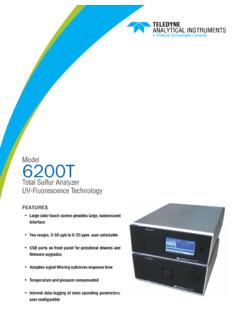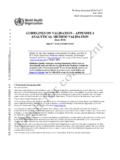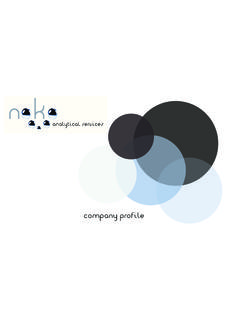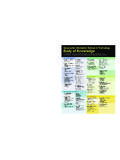Transcription of WHO GUIDELINE ON TRANSFER OF TECHNOLOGY
1 Working document June 2008 RESTRICTED WHO GUIDELINE ON TRANSFER OF TECHNOLOGY DRAFT DOCUMENT FOR COMMENT The need for new WHO guidance for TRANSFER of TECHNOLOGY was discussed at the forty-second meeting of the WHO Expert Committee on Specifications for Pharmaceutical Preparations in October 2007. Colleagues from the WHO Prequalification Programme shared their experience of recently submitted dossiers by, and inspections carried out in, plants that had undergone TECHNOLOGY TRANSFER .
2 TECHNOLOGY TRANSFER is happening worldwide both within and between companies, and within the same country as well as between countries. The Expert Committee, therefore, recommended that WHO guidelines on TRANSFER of TECHNOLOGY be developed. This draft text was subsequently prepared by Mr John Startup, United Kingdom and by Dr Monika Zweygarth, South Africa. Please address comments on this proposal, by 30 September 2008, to Dr S. Kopp, Manager, Quality Assurance, Department of Essential Medicines and Pharmaceutical Policies, World Health Organization, 1211 Geneva 27, Switzerland, fax: (+41 22) 791 4730 or e-mail: with a copy to . _____ World Health Organization 2008 All rights reserved. This draft is intended for a restricted audience only, the individuals and organizations having received this draft. The draft may not be reviewed, abstracted, quoted, reproduced, transmitted, distributed, translated or adapted, in part or in whole, in any form or by any means outside these individuals and organizations (including the organizations' concerned staff and member organizations) without the permission of the World Health Organization.
3 The draft should not be displayed on any web site. Please send any request for permission to: Dr Sabine Kopp, Quality Assurance Programme, Quality & Safety: Medicines, Department of Essential Medicines and Pharmaceutical Policies, World Health Organization, CH-1211 Geneva 27, Switzerland. Fax: (41-22) 791 4730; e-mail: The designations employed and the presentation of the material in this draft do not imply the expression of any opinion whatsoever on the part of the World Health Organization concerning the legal status of any country, territory, city or area or of its authorities, or concerning the delimitation of its frontiers or boundaries. Dotted lines on maps represent approximate border lines for which there may not yet be full agreement. The mention of specific companies or of certain manufacturers products does not imply that they are endorsed or recommended by the World Health Organization in preference to others of a similar nature that are not mentioned.
4 Errors and omissions excepted, the names of proprietary products are distinguished by initial capital letters. All reasonable precautions have been taken by the World Health Organization to verify the information contained in this draft. However, the printed material is being distributed without warranty of any kind, either expressed or implied. The responsibility for the interpretation and use of the material lies with the reader. In no event shall the World Health Organization be liable for damages arising from its use. This draft does not necessarily represent the decisions or the stated policy of the World Health Organization. Working document page 2 SCHEDULE FOR THE PROPOSED ADOPTION process OF DOCUMENT : WHO GUIDELINE ON TRANSFER OF TECHNOLOGY Recommendation made by WHO Expert Committee on Specifications for Pharmaceutical Preparations to prepare the GUIDELINE 15-19 October 2007 Drafting of GUIDELINE by Mr John Startup, United Kingdom January-April 2008 Preparation in WHO style by Dr Monika Zweygarth, South Africa May-June 2008 Mailing of working document for comments August 2008 Consolidation of comments and preparation of revised draft version August-October 2008 Presentation to the forty-third WHO Expert Committee on Specifications for Pharmaceutical Preparations 13-17 October 2008 Follow-up action as necessary November 2008.
5 Mailing of revised, second draft for comments Working document page 3 CONTENTS 1. 2. 3. 4. PRODUCTION: TRANSFER (PROCESSING, PACKAGING AND CLEANING)..8 5. QUALITY CONTROL: ANALYTICAL METHOD 6. ORGANIZATION AND 7. 8. PREMISES AND 9. 10. QUALIFICATION AND 11. Working document page 4 1. INTRODUCTION TRANSFER of processes to an alternative site occur at some stage in the life-cycle of most products, from preclinical development through clinical studies, scale-up and launch, to the post-approval phase. The processes usually transferred are those of manufacturing investigational pharmaceutical products for clinical trials as part of research and development, manufacturing active pharmaceutical ingredients (APIs), manufacturing and packaging established finished pharmaceutical products (FPPs) and/or performing analytical testing.
6 TRANSFER of TECHNOLOGY is defined as a logical procedure that controls the TRANSFER of an established process together with its documentation and professional expertise to a site capable of reproducing the process and its support functions to a predetermined level of performance . Literature searches revealed little information on the subject from national or regional regulatory bodies. Guidance on intra-company transfers was prepared by the International Society for Pharmaceutical Engineering (ISPE) (1). The ever-changing business strategies of pharmaceutical companies increasingly involve intra- and inter-company transfers of TECHNOLOGY for reasons such as the need for additional capacity, relocation of operations or consolidations and mergers. The WHO Expert Committee on Specifications for Pharmaceutical Preparations, therefore, recommended in its forty-second report that WHO address this issue through preparation of WHO guidelines in this area (2).
7 TRANSFER of TECHNOLOGY requires a planned approach using trained and knowledgeable personnel working within a robust quality system, with documentation of data covering all aspects of production and quality control. In order for the TRANSFER to be successful, the following requirements should be met: the faculties and equipment at the sending unit (SU) and at the receiving unit (RU) should be equivalent; adequate trained staff should be available at the RU; and SOPs, protocols and reports, specifications, critical process parameters and supportive data should be transferred from the SU to the RU. A time frame should be defined for the TRANSFER project. Regulatory requirements in the countries of the SU and the RU should be taken into account and interpreted consistently throughout any TRANSFER programme project. TECHNOLOGY TRANSFER can be considered successful if there is documented evidence that the RU can routinely reproduce the transferred product, process or method against a predefined set of specifications as agreed with the SU.
8 TECHNOLOGY TRANSFER projects, particularly those between different companies, have legal and economic implications. If such issues, which may include intellectual property rights, royalties, pricing, conflict of interest and confidentiality, are expected to impact on technical matters in any way, they should be considered before and during planning and execution of the TRANSFER . Working document page 5 2. SCOPE This document gives guidance in principle and provides general recommendations on the necessary activities that should be addressed to conduct a successful intra- or inter-site TRANSFER of TECHNOLOGY as described in the Introduction to this GUIDELINE .
9 The intention is to address the basic requirements needed for a successful TRANSFER in order to satisfy any regulatory authority. The GUIDELINE addresses following areas at the sending unit (SU) and the receiving unit (RU): TRANSFER of production (processing, packaging and cleaning); TRANSFER of analytical methods for quality assurance and quality control; skills assessment and training; organization and management of the TRANSFER ; assessment of premises and equipment; documentation; and qualification and validation. The recommendations provided in this GUIDELINE apply to all dosage forms. Particularly close control of certain aspects will be required for complex formulations such as sterile products, metered-dose aerosols and clinical trials supplies. WHO guidance on manufacture of specific pharmaceutical products (4d,4e) will be useful in this regard. Because each TRANSFER project is unique, the provision of a comprehensive set of guidelines is beyond the scope of this document.
10 This GUIDELINE does not provide guidance on any legal, financial or commercial considerations associated with TECHNOLOGY TRANSFER projects. 3. GLOSSARY Acceptance criteria Measurable terms under which a test result will be considered acceptable. Bracketing An experimental design to test only the extremes of, for example, dosage strength. The design assumes that the extremes will be representative of all the samples between the extremes. Change control (C/C) A formal system by which qualified representatives of appropriate disciplines review proposed or actual changes that might affect a validated status. The intent is to determine the need for action that would ensure that the system is maintained in a validated state. Commissioning The setting up, adjustment and testing of equipment or a system to ensure that it meets all the requirements, as specified in the user requirement specification, and capacities as specified by the designer or developer.















